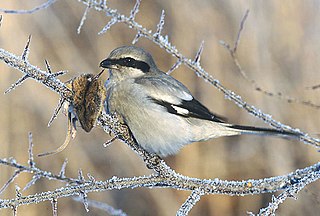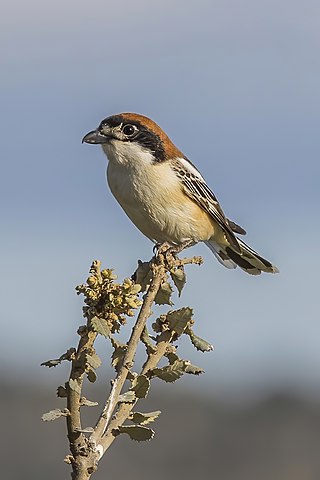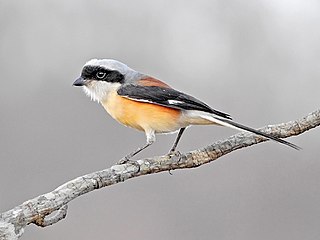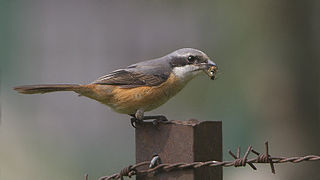
Shrikes are passerine birds of the family Laniidae. The family is composed of 34 species in two genera.

The great grey shrike is a large and predatory songbird species in the shrike family (Laniidae). It forms a superspecies with its parapatric southern relatives, the Iberian grey shrike, the Chinese grey shrike and the American loggerhead shrike. Males and females are similar in plumage, pearly grey above with a black eye-mask and white underparts.

The red-backed shrike is a carnivorous passerine bird and member of the shrike family, Laniidae. Its breeding range stretches from Western Europe east to central Russia. It is migratory and winters in the eastern areas of tropical Africa and southern Africa.

The woodchat shrike is a member of the shrike family Laniidae. It can be identified by its red-brown crown and nape. It is mainly insectivorous and favours open wooded areas with scattered trees such as orchards, particularly when there is bare or sandy ground. The woodchat shrike breeds in southern Europe, the Middle East and northwest Africa, and winters in tropical Africa.

The Iberian grey shrike is a member of the shrike family. It is closely related to the great grey shrike, Lanius excubitor, and its plumage is generally similar to the great grey shrike apart from the differences noted below. The Iberian was previously considered conspecific with the great grey; where they co-occur, they do not interbreed and are separated by choice of habitat.

The lesser grey shrike is a member of the shrike family Laniidae. It breeds in South and Central Europe and western Asia in the summer and migrates to winter quarters in southern Africa in the early autumn, returning in spring. It is a scarce vagrant to western Europe, including Great Britain, usually as a spring or autumn erratic.

The northern shrike is a large songbird species in the shrike family (Laniidae) native to North America and Siberia. Long considered a subspecies of the great grey shrike, it was classified as a distinct species in 2017. Six subspecies are recognised.

The long-tailed shrike or rufous-backed shrike is a member of the bird family Laniidae, the shrikes. They are found widely distributed across Asia and there are variations in plumage across the range. The species ranges across much of Asia, both on the mainland and the eastern archipelagos. The eastern or Himalayan subspecies, L. s. tricolor, is sometimes called the black-headed shrike. Although there are considerable differences in plumage among the subspecies, they all have a long and narrow black tail, have a black mask and forehead, rufous rump and flanks and a small white patch on the shoulder. It is considered to form a superspecies with the grey-backed shrike which breeds on the Tibetan Plateau.

The brown shrike is a bird in the shrike family that is found mainly in Asia. It is closely related to the red-backed shrike and isabelline shrike. The genus name, Lanius, is derived from the Latin word for "butcher", and some shrikes are also known as "butcher birds" because of their feeding habits. The specific cristatus is Latin for "crested", used in a broader sense than in English. The common English name "shrike" is from Old English scríc, "shriek", referring to the shrill call.

The grey shrikethrush or grey shrike-thrush, formerly commonly known as grey thrush, is a songbird of Australasia. It is moderately common to common in most parts of Australia, but absent from the driest of the inland deserts. It is also found in New Guinea.

The bay-backed shrike is a member of the bird family Laniidae, the shrikes, resident in South Asia.

The black-headed bulbul is a member of the bulbul family, Pycnonotidae. It is found in forests in south-eastern Asia.

Lanius, the typical shrikes, are a genus of passerine birds in the shrike family Laniidae. The majority of the family's species are placed in this genus. The genus name, Lanius, is derived from the Latin word for "butcher", and some shrikes are also known as "butcher birds" because of their feeding habits. The common English name "shrike" is from Old English scríc, "shriek", referring to the shrill call.

The tiger shrike or thick-billed shrike is a small passerine bird which belongs to the genus Lanius in the shrike family, Laniidae. It is found in wooded habitats across eastern Asia. It is a shy, often solitary bird which is less conspicuous than most other shrikes. Like other shrikes it is predatory, feeding on small animals. Its nest is built in a tree and three to six eggs are laid.

The Taita fiscal or Teita fiscal is a member of the shrike family found in east Africa from southeastern South Sudan, southern Ethiopia, and western Somalia to northeastern Tanzania. Its habitat is dry open thornbush and acacia and other dry open woodland.

The bull-headed shrike is a passerine bird of eastern Asia belonging to the shrike family Laniidae.

The Chinese grey shrike is a species of bird in the family Laniidae. It is found in China, Japan, North Korea, South Korea, Mongolia, and the Russian Far East. Its natural habitat is temperate forests. The giant grey shrike of central China was formerly considered a subspecies.

The grey-backed shrike is a bird in the family Laniidae inhabiting South-east Asia.
The mountain shrike or grey-capped shrike, is a species of bird in the family Laniidae. It is endemic to the Philippines.

The steppe grey shrike is a large subspecies of songbird in the shrike family (Laniidae) native to Central Asia and parts of northern China, Iran, Afghanistan and Pakistan. Formerly considered a subspecies of the southern grey shrike complex, it is now classified as a subspecies of the great grey shrike.



















